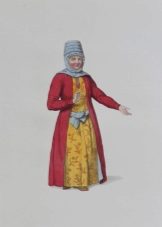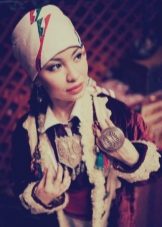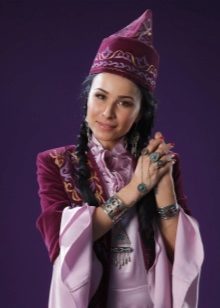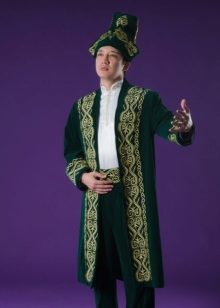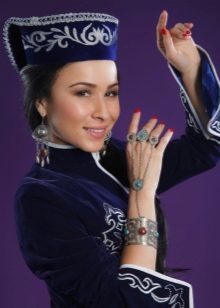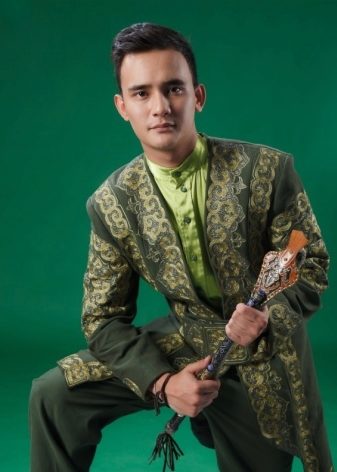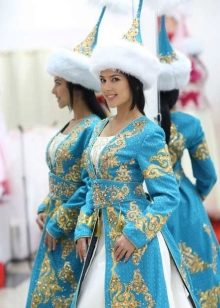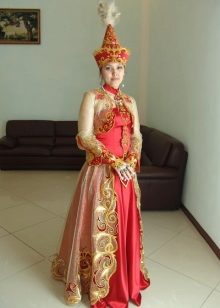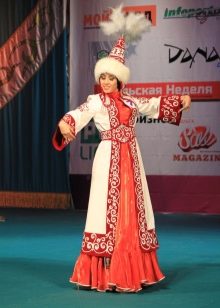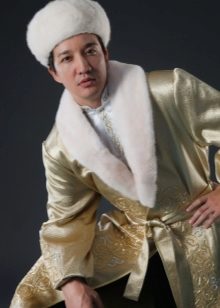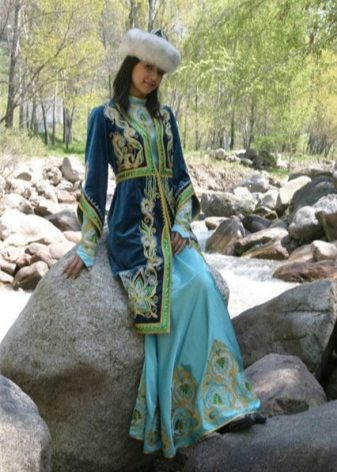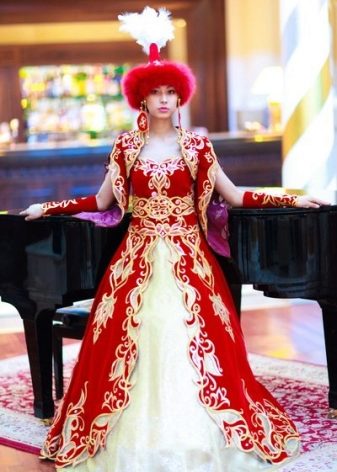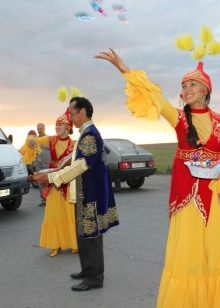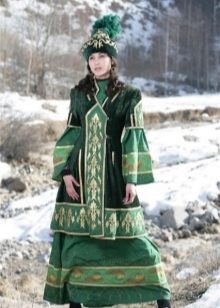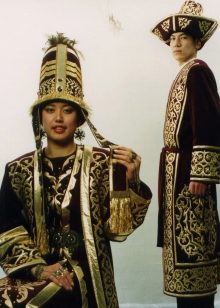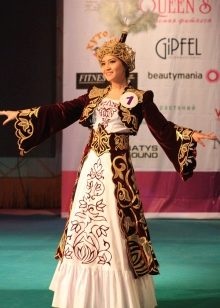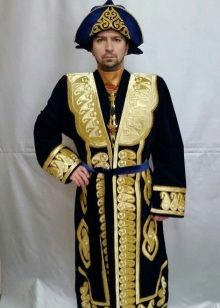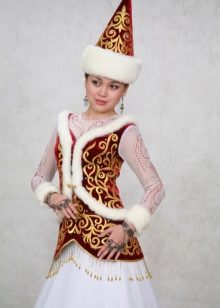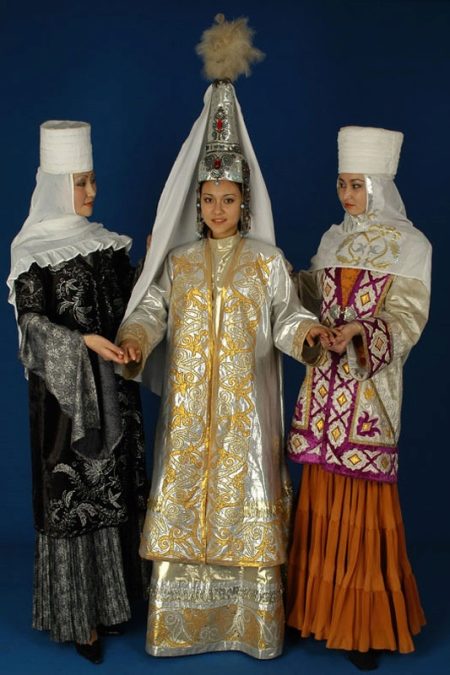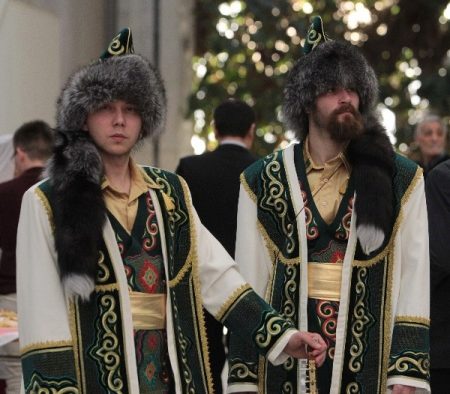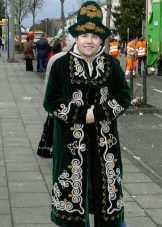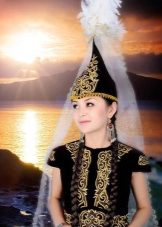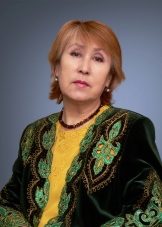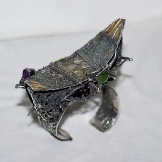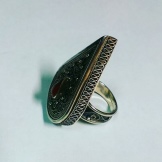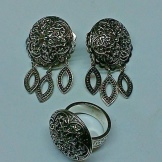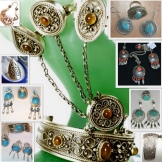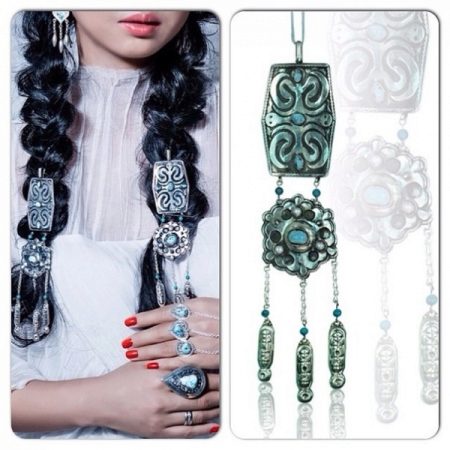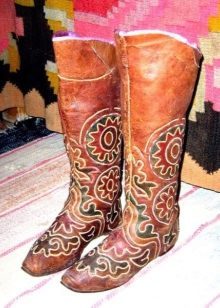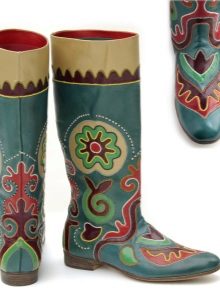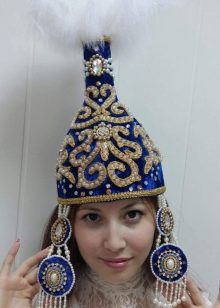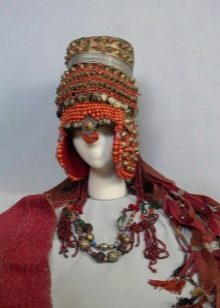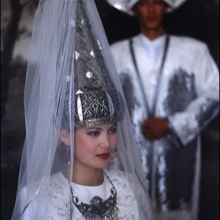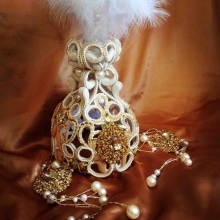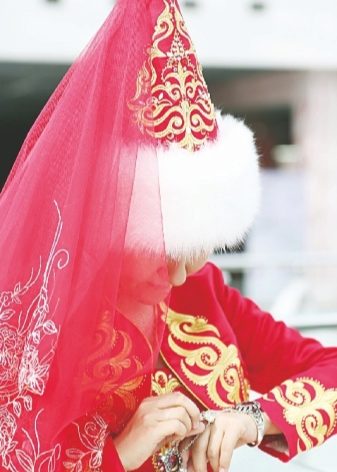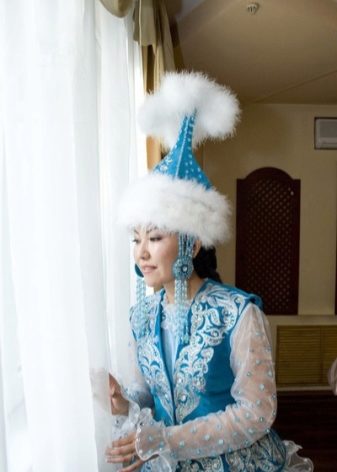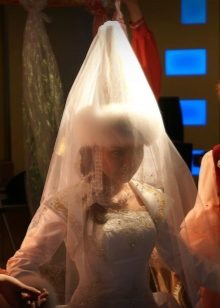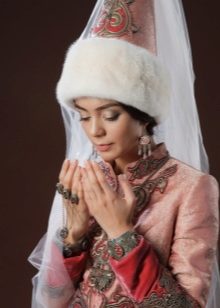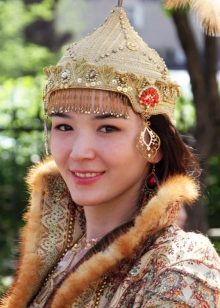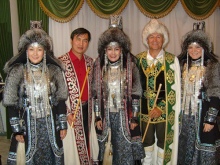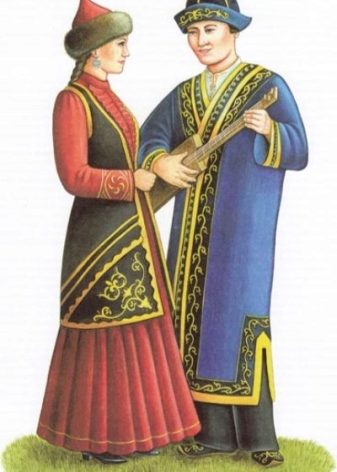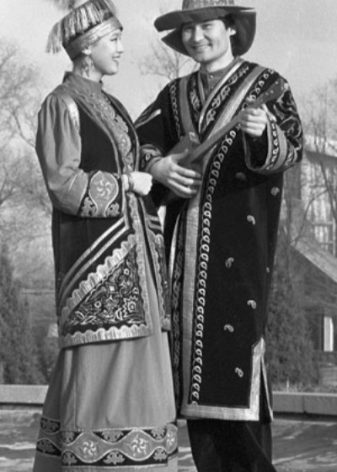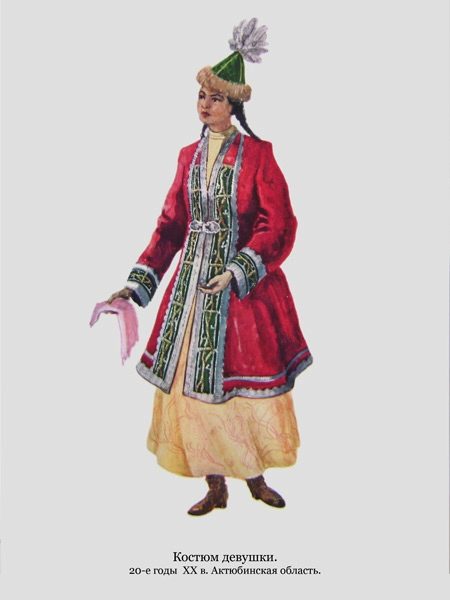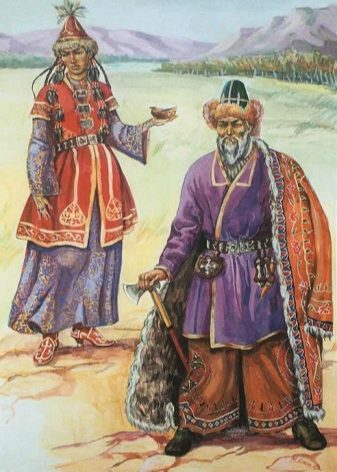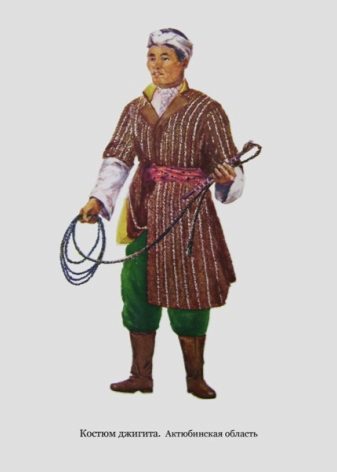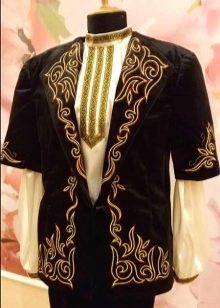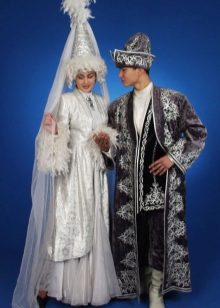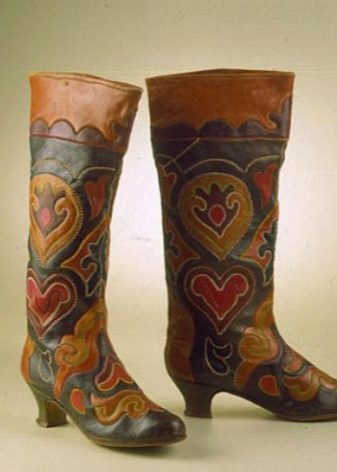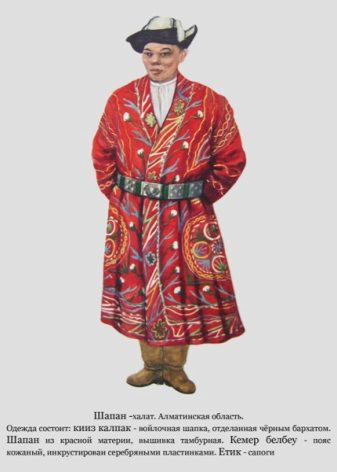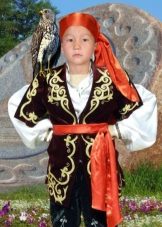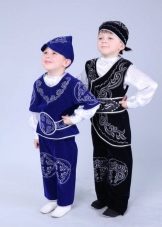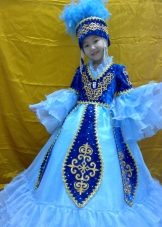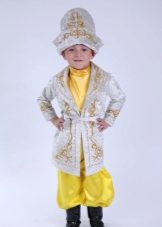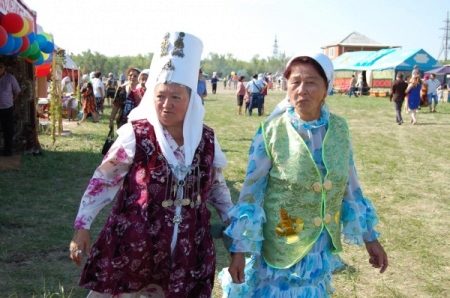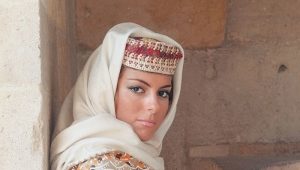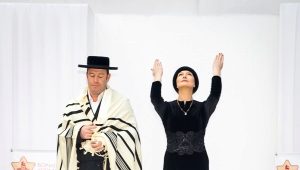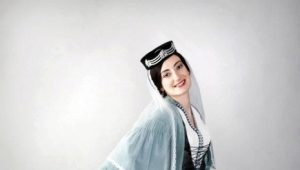Kazakh national costume
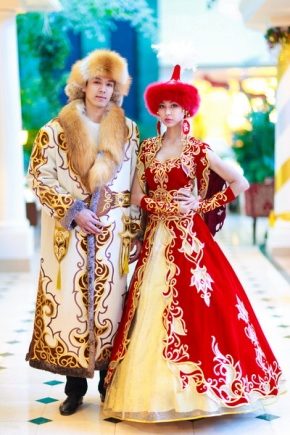
Kazakh national costume began to form about 5-6 centuries ago. It was at this time that the identity of the Kazakhs can be called formed. She reflected in the national dress of this nation.
A bit of history
The modern version of the Kazakh national costume was not only formed for a long time, but was constantly changing. Neighboring peoples with the Kazakhs greatly influenced local fashion. The Tatars, Russian, Central Asian peoples made their contribution. But at all times, Kazakh clothing was distinguished by a large variety of decorative elements and ornaments, the smell from right to left, the rim. Embroidery and national patterns served as decorations, besides the Kazakhs believed that they were protecting them from evil forces.
Features
The following distinctive features in the Kazakh costume can be distinguished:
- outerwear has the character of hinged and always smells on the left side. It is inherent in men's and women's costumes;
- fitted fit;
- women's suits are richly decorated with frills, luxurious fringe and border;
- the presence of high caps, which are decorated with precious stones, as well as feathers or embroidery;
- embroidery reflects the national ornament, is performed in the form of Lurex, patterned weaving;
- common materials - leather, fur, woolen cloth, felt.
Cotton fabrics were used to sew light clothing and underwear. They were delivered by traders along the silk road, along with them the brocade, silk, velvet and other expensive fabrics were supplied to the Kazakhs. Outerwear was sewn from goat, colt, saiga hides, sheepskin products were popular.
Colors and shades
The colors of the Kazakh costume have traditionally been and remain bright and juicy. They are evidence of wealth, wealth, luxury. These are all shades of green, blue, gold, red, which can be seen in both women's and men's attire. Elements of national clothes are also used by modern Kazakh designers to create traditional clothes. They pay tribute to the old, so outfits come out as before bright and catchy. Especially decorated with rich ornaments.
Fabrics
Fabrics of the national costume of the Kazakhs depend on the degree of wealth of the owner. Brocade, fine silk, soft velvet, valuable furs speak of affluence. They turned away outerwear, the edges of headdresses. Widely used woolen and cotton fabrics.
Cut
Both men's and women's clothing has always been a fitted cut. Products traditionally expand to the bottom. Also bathrobes can be straight, long sleeves. In men, traditional clothing are wide trousers. The cut of dresses for girls and unmarried women is long, fitted, decorated with frills and frills. Headgear are cone-shaped.
Accessories and decorations
Kazakhs pay much attention to the wealth of jewelry. They are distinguished by a variety of materials and a manner of execution. They are used in all garments. For example, stripes and robes, and shoes, and on headdresses.
Depending on wealth, metals such as gold, silver, and bronze were used. Of the gems, the Kazakhs preferred carnelian, mother of pearl, pearls, corals, and colored glass.
Especially distinguished rings. They have different names, which depends on the form. For example, there is a bird beak ring. Bracelets, pendants and earrings can be forged and very massive.
Jewelry was needed to give originality and highlight the rank of the costume owner, they were also independent elements. For people of different ages, marital status, rank, there are different types of jewelry. They also differ by territory.
Footwear
Kazakh national footwear reflects the nomadic life of this nation. Because of the need for constant change of places in it, high boots prevail. In wide tops it is convenient to refuel pants for greater heat preservation.
- Boots for the summer period could be on the heel. In the old socks sewn curved. Young girls wore shoes with appliqué decorations and embroidery.
- Boys had a popular heel of about 8 cm. Elderly wore soft boots without heels for convenience. On top of them were wearing galoshes or leather shoes.
- Poor people, shepherds wore boots made of felt with leather soles. The poor were forced to wear shoes like sandals, which was a leather sole that was attached to the leg with straps.
The beauty of the wedding dress
The national wedding dress of the Kazakh bride wears the complex name Toy Uzatu Koilek. It is made from expensive fabrics such as silk or satin, organza or taffeta. It is necessarily present Kazakh ornament and delicate embroidery. It is made of beads, decorated with gold cords and ribbons.
Wedding attire, that in ancient times, that today, is distinguished by an original headdress. He is called saukele. This decoration was relevant until the 19th century. Saukele is sewn in the shape of a cone, about 70 cm long. As usual it is decorated with jewels. For this they used coins, corals, pearls, zloty inserts, precious stones, metal plates.
Chin and whiskey pendants were attached to the device. A ribbon woven from golden threads and trimmed with fringe hung from the back to the back. On the back of my head it was nice to depict a symbol of prosperity - a fish head. It is customary to wear a velvet or silk scarf over the wedding gown.
Wedding headdress made to wear during the first year of family life. Then it gets only on big holidays. Saukele is not only beautiful, but also a very expensive headdress. In ancient times up to 100 best horses were given for it. And the masters worked on such a dress for at least a year. Until now, according to the Kazakh legends, it is believed that the richer the saukele of the bride, the happier and more successful her family life will be.
Over the wedding dress the bride can wear a camisole. It is sewn to match the dress, it is also decorated with ornaments, coins, stones.
The color of the fabric of the wedding dress plays an interesting role. Instead of the white color we are used to, Kazakhs prefer both red and blue. Red symbolizes youth, life in its prime. Blue is a symbol of a peaceful sky above your head, warmth and comfort. He speaks of purity and purity. If the wedding date falls on a warm season, then white, pink, cream shades are more often used.
None of the Kazakh wedding dress will not do without jewelry. These are bracelets, and rings, and necklaces, and pendants.
Varieties
Female
From the Turkic tribes to the Kazakh women passed on - Zhaulyk, headgear. It was sewn of silk fabric, it could be trimmed with fur. Women wore beldemshe skirts. They wore robes or camisoles.
Another option is a dress whose skirt was flared. It was called Kulish Koilek. The Russian costume influenced the creation of a different style of dress, zakh koylek. It used a turn-down collar and then popular pleated yoke.
Women's outerwear was presented in the form of a shalan, a bathrobe with a warm wool lining for the winter season.
Male
Men's national costume includes a hat, sharavara and camisole. He suggests the presence of a special headdress. This dress resembles the caps of ancient Scythians and is called Murak or I-Yrkalpak.
Bloomers or Shalbar are sewn with sheep skin inserts. It protects the skin against friction and makes riding more comfortable. The edges of the pants tucked into boots.
Beshmet, that is, the Kazakh in Kazakh can be of different colors, it is sewn insulated for the cold season and tied with a belt. Under outerwear, Kazakhs wear zheide - underwear made from cotton fabric. Silk is less commonly used. Over the suit, men wear a fur coat or a long-robe to protect themselves from the cold.
Men wore two types of shoes: either boots (a low heel was allowed) or leather Czech shoes. Shoes also decorated with embroidery.
The special part of both the female and male Kazakhs were always belts. They were sewn from different fabrics. There were special holiday models, skillfully embroidered and decorated with pendants, semi-precious stones.
Child
National Kazakh outfits for children are reduced models of adult costumes. They are just as bright, beautiful and rich in decorations.
Modern models
Today, the national dress of the Kazakh people is preserved in the villages. It continues to be worn by people of older generations. And it is also a source of inspiration for modern designers and fashion designers.
Modern Kazakh costumes are distinguished by elegance, subtly emphasizing the beauty and pride of the Kazakh people. Their main feature is in national ornaments, which distinguish the Kazakh style in any style of clothing.
